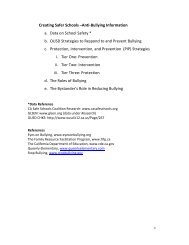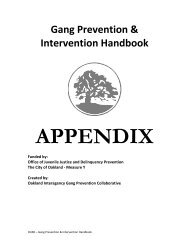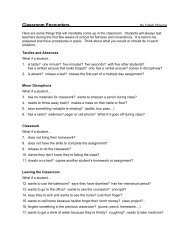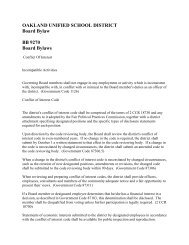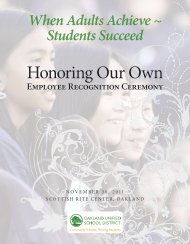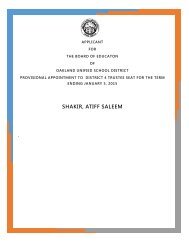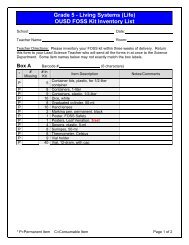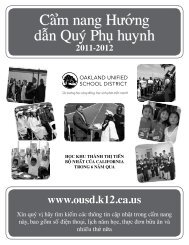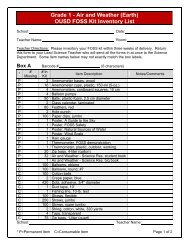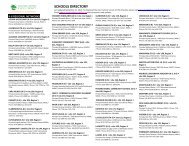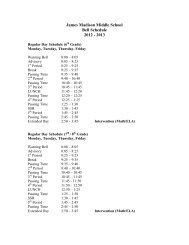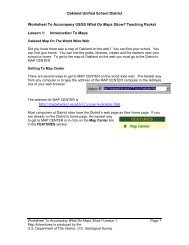Science Framework, part 1 - Free Downloads (CA Dept of Education)
Science Framework, part 1 - Free Downloads (CA Dept of Education)
Science Framework, part 1 - Free Downloads (CA Dept of Education)
- No tags were found...
You also want an ePaper? Increase the reach of your titles
YUMPU automatically turns print PDFs into web optimized ePapers that Google loves.
21tably challenge citizens to rethinktheir ideas and beliefs. For example, asnew genetically modified crops andlivestock are developed by scientists,some people have expressed concernabout food safety and the ethics <strong>of</strong>such practices. On the other hand,people in developing countries have acompelling interest to use the newtechnologies to rid themselves <strong>of</strong> famineand diseases. Those types <strong>of</strong> trade<strong>of</strong>fsare likely to become the focus <strong>of</strong>intense public discussion and politicaldebate.The presentation <strong>of</strong> some scientificfindings or practices may be troublingto students who genuinelybelieve that those findings or practicesconflict with their religious or philosophicalbeliefs. Dealing constructivelyand respectfully with thosebeliefs while holding firm to the nature<strong>of</strong> science is one <strong>of</strong> the greatestchallenges to public school teachers.Scientifically literate students needto understand clearly the major scientifictheories and the principles behindthe scientific method. They must alsounderstand that though the scientificmethod is a powerful process for predictingnatural phenomena, it cannotbe used to answer moral and aestheticquestions. Nor can it be used to testhypotheses based on supernatural intervention.<strong>Science</strong> exclusively concernsitself with predicting the occurrenceand consequences <strong>of</strong> natural events.This concern is explicitly expressed inStandard 7.10 <strong>of</strong> grade seven <strong>of</strong> theHistory–Social <strong>Science</strong> Content Standards:“Students analyze the historicaldevelopments <strong>of</strong> the Scientific Revolutionand its lasting effect on religious,political, and cultural institutions” 10The students go on to consider thisanalysis in terms <strong>of</strong> the roots <strong>of</strong> thescientific revolution, the significance <strong>of</strong>new scientific theories, the influence <strong>of</strong>new scientific rationalism on thegrowth <strong>of</strong> democratic ideas, and thecoexistence <strong>of</strong> science with traditionalreligious beliefs.Chapter 2The Nature <strong>of</strong><strong>Science</strong> andTechnologyNotes1. <strong>Science</strong> Content Standards for California Public Schools, Kindergarten Through Grade Twelve.Sacramento: California De<strong>part</strong>ment <strong>of</strong> <strong>Education</strong>, 2000, p. 25.2. Ibid., p. 2.3. Ibid., p. 52.4. Ibid., p. 44.5. Mathematics <strong>Framework</strong> for California Public Schools, Kindergarten Through Grade Twelve. Sacramento:California De<strong>part</strong>ment <strong>of</strong> <strong>Education</strong>, 2000, p. 227.6. <strong>Science</strong> Content Standards, p. 52.7. A Section 504 accommodation plan is a document typically produced by school districts incompliance with the requirements <strong>of</strong> Section 504 <strong>of</strong> the federal Rehabilitation Act <strong>of</strong> 1973. Theplan specifies agreed-on services and accommodations for a student who, as the result <strong>of</strong> anevaluation, is determined to have a “physical or mental impairment [that] substantially limitsone or more major life activities.” In contrast to the Individuals with Disabilities <strong>Education</strong> Act(IDEA), Section 504 allows a wide range <strong>of</strong> information to be contained in a plan: (1) the nature<strong>of</strong> the disability; (2) the basis for determining the disability; (3) the educational impact <strong>of</strong>the disability; (4) necessary accommodations; and (5) the least restrictive environment in whichthe student may be placed.



